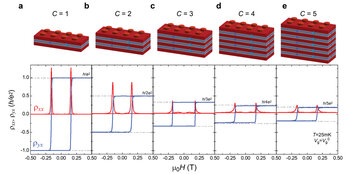Quantum Insulators May Bring Resistance-Free Current Transfer to Electronics
Cui-Zu Chang is currently an assistant professor of Physics at The Pennsylvania State University. His research focuses on a variant of magnetic topological insulators called quantum anomalous Hall insulators. A topological insulator is a special material in which the interior is an insulator, but the surfaces are metallic. This property allows electrons to travel along the metallic surfaces but not inside. Such quantum anomalous Hall insulators can transmit current with no resistance, like a superconductor.
The original quantum Hall effect required an external magnetic field to operate. This hampers the development of energy-efficient technologies. The need for an external magnetic field can be circumvented by adding internal magnetic impurities into the material.
The possibility of a quantum Hall effect at zero magnetic field, which is now known as the quantum anomalous Hall (QAH) effect, was first envisioned by the British physicist and 2016 Nobel Prize laureate Duncan Haldane in 1988. Cui-Zu Chang was the first to experimentally realize the QAH effect.
There is a particularly important difference between superconductors and QAH devices that dramatically impacts their usefulness in electronics.
“In superconductors the carrier density is super high, so it is difficult to fabricate a gate for it. A gate is like a valve, which can turn the current on or off. However, in the QAH insulators, we can do this.”
This is essentially what the extremely ubiquitous semi-conductors of today do. They allow us to manipulate current in clever ways to make fantastically complex electronic devices. However, we have all but reached the end of the road when it comes to how small we can make electronic components.
“When we make them smaller, heat production will greatly increase, and we're close to where heat production in these chips will rise to unmanageable levels.”
Enter the QAH insulator. Since they transmit current without loss, they also do not generate heat. If their potential is realized, it could literally lead to a quantum leap in circuit design.
However, to realize this potential, the QAH insulator must have enough channels where it transmits current. A basic QAH insulator is one insulator core with a conducting layer on each side, creating one channel in each direction. There is a problem, as each contact point, the "end of the channel", creates resistance. But this resistance decreases as you add more channels. Cui-Zu Chang has managed to create a QAH insulator with several channels, a key breakthrough if the QAH insulators are to be genuinely useful.
Scientists use a technique called molecular beam epitaxy, or MBE, to make these complex structures.
“In molecular beam epitaxy you have a chamber with an ultra-high vacuum. In this vacuum chamber you can evaporate the elements you want to use to build your structure, then atoms wander to the structure you're building.”
In this way, you can build the structure atomic layer by atomic layer, with extreme precision.
“When the sample is ready in the MBE chamber, we transfer it to another chamber, the ARPES chamber without breaking the ultra-high vacuum. In that chamber, we can examine the properties of our samples and optimize the growth recipes.”
Cui-Zu Chang points out that the research on the QAH insulators is still in its early days, and practical applications are still a considerable way off. One of the reasons is that extremely low temperatures are necessary to realize this effect, at most a few Kelvin.
“In order to use the QAH effect in electronics, we need to find materials that works at least above 77 K, which temperature that can be achieved by liquid nitrogen.”
This may seem like an awfully long way to go. But he doesn't think it's insurmountable.
“In the beginning, superconductors needed to be cooled with liquid helium to a few Kelvin. Now we have superconductors working in at 130–140 Kelvin in reasonably normal environments. We now have QAH materials that could work in 7–8 K. That still leaves a long way to go. But science is a step-by-step process. I am optimistic that we can reach the QAH effect above 77 K.”
When he is not in the lab exploring the boundaries of quantum physics, Cui-Zu Chang regularly takes a trip to the local badminton court.
“My wife always told me to exercise, he says with a smile. Physical exercise is important. It's an extremely popular sport in China, so I guess it felt natural for me to continue when I moved to the US. It's also great fun. I've been playing close to fifteen years now.”
Cui-Zu Chang earned his doctoral degree in condensed matter physics at Tsinghua University in Beijing and did his postdoc at MIT. He's also received a slew of awards and honors, including Outstanding Young Researcher Award from the International Organization of Chinese Physicists and Astronomers in 2019, and the National Science Foundation Faculty Early Career Development award in 2019, Army Research Office Young Investigator Program award in 2018, Alfred P. Sloan Research Fellowship in 2018, and the Gordon and Betty Moore EPiQS Materials Synthesis Investigator Award in 2019.
Kim Bergström - Science Journalist - Ord & Vetande

